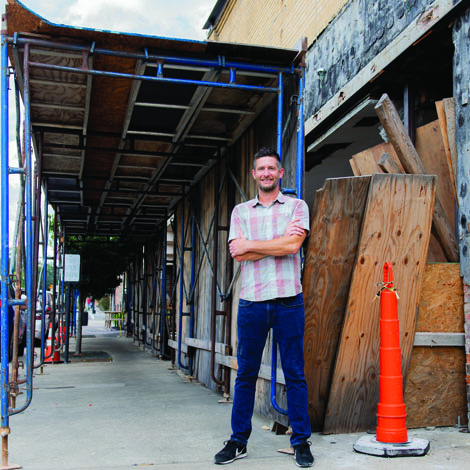
By Sara Sobota
The city of Conway, established in 1732, has a fascinating and well-documented history. However, Alan Todd, senior lecturer in the Edwards College Department of Philosophy and Religious Studies, believes much of its history is untapped, that it could – and should – be further explored and expanded. The lens through which Todd plans to investigate and analyze Conway’s history, as well as that of its community members, is the wood originally used to build its oldest structures.
Todd’s interest in using wood to tell the history of Conway began with the old Abrams Department Store, a family business established in 1908. After the original building was destroyed by fire and rebuilt in 1949, the Abrams family continued to operate out of the iconic Laurel Avenue structure for three generations, until owner Sam Abrams shuttered it because of age-related health issues. The building sat vacant and deteriorating for several years until restaurant owner Chris Snyder purchased it in 2021 for expansion of Crooked Oak Tavern.  Todd’s plans for the Abrams building and others like it – historic Conway structures that are solidly built with quality wood no longer widely available, and which are slated for demolition – are twofold. First, Todd hopes to involve CCU students in writing the history of the buildings and their inhabitants; in the Abrams' case, it would establish a history of Jewish merchants and residents who have lived and worked in the area since the mid-19th century.
Todd’s plans for the Abrams building and others like it – historic Conway structures that are solidly built with quality wood no longer widely available, and which are slated for demolition – are twofold. First, Todd hopes to involve CCU students in writing the history of the buildings and their inhabitants; in the Abrams' case, it would establish a history of Jewish merchants and residents who have lived and worked in the area since the mid-19th century.
“No one’s really written that history yet,” said Todd.
The newly recorded history would “live” in a QR code posted at Crooked Oak Tavern that directs readers to a website dedicated to the Abrams family.
Second, in future projects, Todd hopes to create a system for learning history through analysis of the wood as a building is being deconstructed, using techniques he’s learned through scholarly work.
“We would salvage old wood from buildings that are dilapidated or need to come down, but rather than sending it to the dump, we collect it, take the nails out, and process it, and we also write the history of the structure using drones that would record data as it comes down. It can locate things in time, so after everything comes down, by using footage, you can recreate a virtual reality rendering of where that wood came from, the actual physical spot. This all gets QR coded, including the wood. Then we could repurpose that wood for other projects.”
Todd is in the process of creating a Quality Enhancement Project (QEP) course that would start the history-recording process of the Abrams building. The course would pull elements of religious studies, history, and digital cultural and design together to allow students to create a sort of community-oriented digital signpost.
“The course title will be something like Civic Religion,” said Todd. “It will involve thinking about religion through an anthropological lens, how material objects become part of our orbits, and how they have agency, all of which would involve deconstruction and also history writing.”
With Edwards College efforts, the landscape of Conway history could be broadened to become both more inclusive and more accessible.


